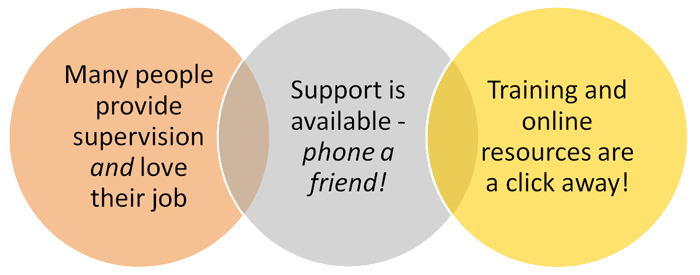Supervision is a collaborative process and is ultimately about making a connection. The good news is that there is no secret to supervision. The reality is that:

Resources to get you started
- Get clear about what your responsibilities as a supervisor are.
- Need a few quick tips to jump start your supervision style? Take a look at our handy Super Supervision guide.
- Want to learn and laugh at the same time? Check out Ask a Manager for some of the best advice on management and supervision.
- Shari Harley, author of How to Say Anything to Anyone, has helpful information on giving staff effective feedback. Learn from her by watching a few of her videos here.
Training new advocates
One of your most important roles is to orient and train new advocates. You play a key role in helping advocates get off to a good start and avoid common traps and burn-out.
Advocates need to understand survivor-driven advocacy, where their job with survivors is to:
- share power
- respect their strengths, cultures, and community
- accept and meet survivors where they are
… as well as to model and contribute to your program being:
- flexible and for the whole person, not just the abuse
- survivor-driven, not program-driven
- culturally competent (see our Crossing Borders assessment guide)
- action-oriented
Here are a few resources to get started:
- Talk about rescuing and taking off our superhero capes. Why is rescuing harmful to our goals of freedom and liberty? How can it re-enforce the abuser’s power? What situations might trigger a rescue response for you, and how will you get support?
- Share principles of survivor-centered advocacy, and unintended consequences of common practices done in the name of “keeping survivors safe.” Check out WSCADV’s Survivor-Defined Advocacy webinar.
- Discuss common myths about the advocate’s role. Are you ready to talk about why the following statements are not only incorrect but deeply contrary to survivor-driven advocacy?
- “Protection orders make survivors safe and I should encourage survivors to get one.”
- “I should always encourage my clients to cooperate with prosecutors.”
- “My goal should be to help survivors leave the abuser since leaving is the safest and best outcome.”
- “Since survivors are beaten down by the abuse, they can’t make good decisions until I empower them.”
- “Survivors who reunite with their abuser put their kids at risk.”
(Not sure how to answer? Check out pages 29-31 of Mission-focused management and empowerment practice: A handbook for Executive Directors of DV Programs by Cris Sullivan, Pennsylvania Coalition Against Domestic Violence.)
- Provide training and job shadowing opportunities with a focus on core principles. Send new advocates to WSCADV’s Advocacy for Rookies training, or to another program for training or job shadowing with experienced advocates.
Nuts and bolts of supervision
- So how do you actually supervise? Mixed feelings (and fear and anxiety!) are normal. Find new peers and guidance on being the boss. Don’t be the manager who doesn’t manage. Stay involved and support staff without micro-managing.
- Feel awkward about supervising former peers? Avoid these common traps and do three things to get off to a healthy start.
- Regular one-on-ones are a cornerstone of supervising. However, if you find yourself just going through the motions with staff, make your check-ins more useful, set goals together, and ask good questions at check-ins.
- Not sure what to say or how to say it? Try brief scripts and questions to get beneath the surface, while avoiding these phrases.
- Feel like you don’t really deserve a leadership role? You may be suffering from Imposter Syndrome (especially if you are a person of color, woman, and/or belong to other historically marginalized groups). If lack of confidence is ruining your work day, try this healthy dose of resiliency practices, self-care, and work journaling.
- Race, racism, and racial equity goes to the heart of our work to end violence. Nonprofit Unicorns, let’s talk about why trying to be colorblind hurts rather helps. We love this video on how to stop worrying and love talking about race. As a staff leader, you make a big difference just by talking in the workplace about what is happening to Black and Brown people in our country today. Lastly, here are some tips on a few real ways white bosses can do right by staff of color.
- If you’d rather clean the office fridge or do just about anything rather than lead another staff meeting, try these three rules for running effective meetings.
- Check out our online trainings How to Hire Great Advocates and Staff Retention.